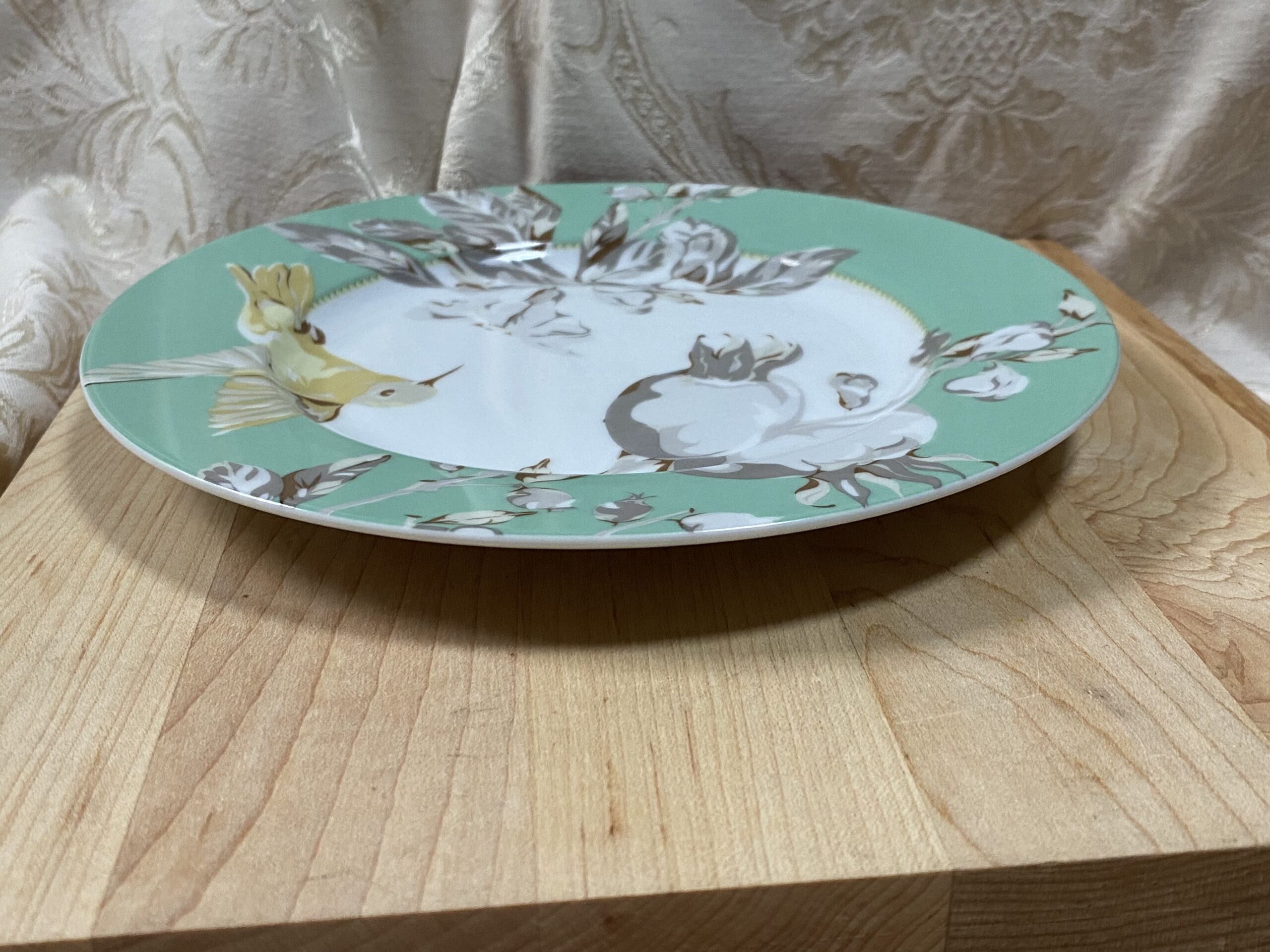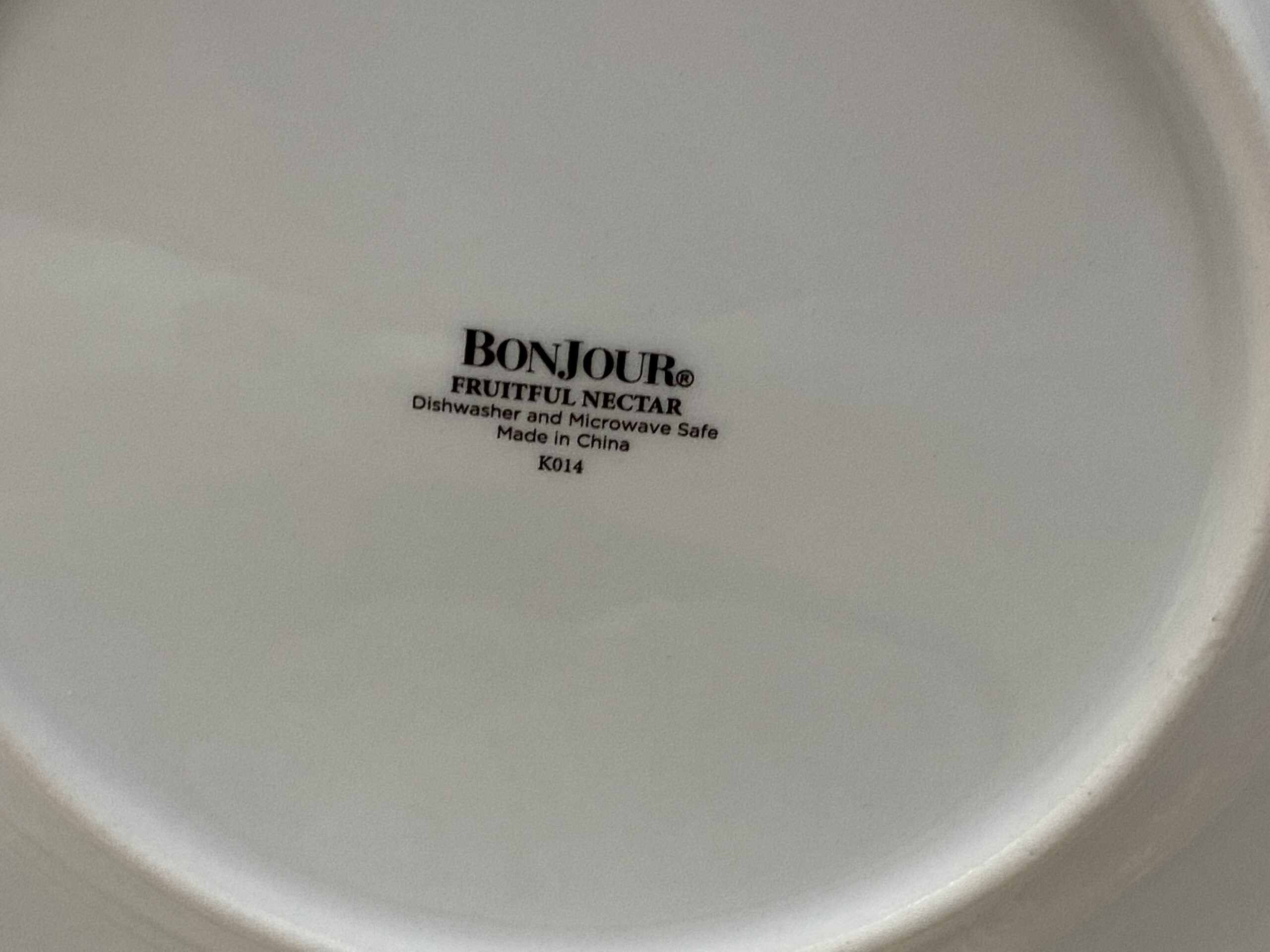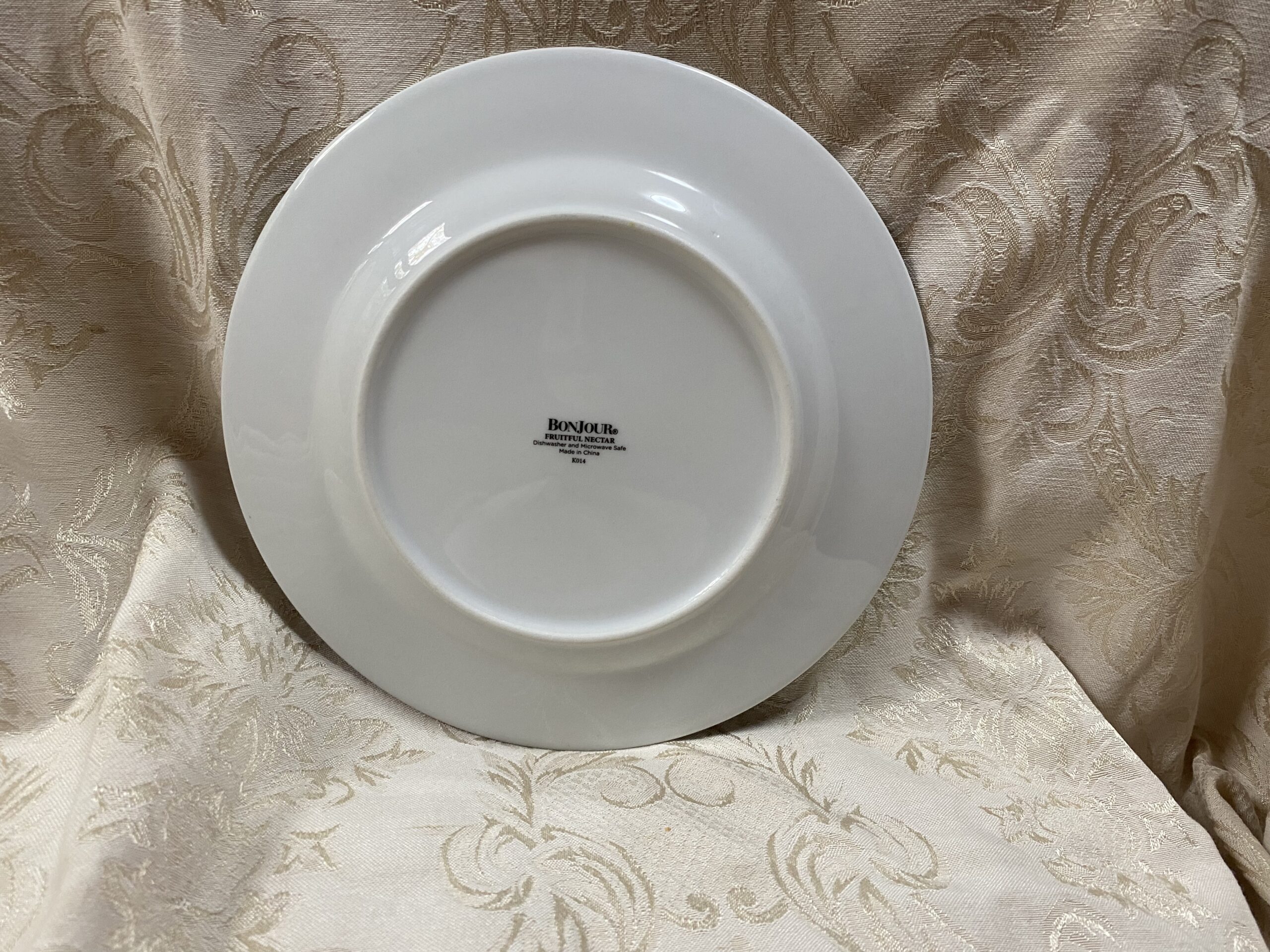Bonjour Fruitful Nectar Dish (Made in China): 56 ppm Lead, 13 ppm Cadmium & 65 Antimony. Food surface is safe by all standards.

 XRF test results for the dish pictured.
XRF test results for the dish pictured.
The food surface of this dish tested safe by all standards. The back mark is painted with high-Lead black paint (1,521 ppm Lead).
Reading #1) Teal blue on the food surface of the dish
60-second test
- Lead (Pb): 45 +/- 11 ppm
- Cadmium (Cd): 12 +/- 5 ppm
- Mercury (Hg): non-detect
- Bromine (Br): non-detect
- Chromium (Cr): 5,712 +/- 440 ppm
- Vanadium (V): 1,061 +/- 551 ppm
- Iron (Fe): 1,451 +/- 137 ppm
- Cobalt (Co): 394 +/- 68 ppm
- Copper (Cu): 62 +/- 23 ppm
- Zinc (Zn): 1,575 +/- 62 ppm
- Titanium (Ti): 5,253 +/- 1,046 ppm
- Zirconium (Zr): 603 +/- 17 ppm
- Niobium (Nb): 237 +/- 16 ppm
- Indium (In): 13 +/- 6 ppm
- Tin (Sn): 32 +/- 8 ppm
- Bismuth (Bi): 217 +/- 15 ppm
- No other metals detected in consumer goods mode.
Reading #2) Yellow of hummingbird
60-second test
- Lead (Pb): 50 +/- 11 ppm
- Cadmium (Cd): 9 +/- 5 ppm
- Mercury (Hg): non-detect
- Bromine (Br): non-detect
- Chromium (Cr): 843 +/- 288 ppm
- Vanadium (V): 3,054 +/- 634 ppm
- Iron (Fe): 1,221 +/- 127 ppm
- Cobalt (Co): 99 +/- 52 ppm
- Nickel (Ni): 232 +/- 51 ppm
- Copper (Cu): 78 +/- 23 ppm
- Zinc (Zn): 1,686 +/- 64 ppm
- Titanium (Ti): 23,000 +/- 1,400 ppm
- Zirconium (Zr): 1,658 +/- 37 ppm
- Indium (In): 12 +/- 6 ppm
- Tin (Sn): 190 +/- 11 ppm
- Antimony (Sb): 65 +/- 11 ppm
- Bismuth (Bi): 217 +/- 15 ppm
- No other metals detected in consumer goods mode.
Reading #3) White background surface of the dish
60-second test
- Lead (Pb): 45 +/- 10 ppm
- Cadmium (Cd): 12 +/- 4 ppm
- Mercury (Hg): non-detect
- Bromine (Br): non-detect
- Chromium (Cr): non-detect
- Iron (Fe): 1,737 +/- 142 ppm
- Niobium (Nb): 226 +/- 16 ppm
- Indium (In): 13 +/- 6 ppm
- Tin (Sn): 32 +/- 7 ppm
- Antimony (Sb): 17 +/- 10 ppm
- Bismuth (Bi): 128 +/- 12 ppm
- No other metals detected in consumer goods mode.
Reading #4) Gray / brown area of fruit of dish
60-second test
- Lead (Pb): 56 +/- 11 ppm
- Cadmium (Cd): 13 +/- 5 ppm
- Mercury (Hg): non-detect
- Bromine (Br): non-detect
- Chromium (Cr): 530 +/- 273 ppm
- Vanadium (V): 1,910 +/- 581 ppm
- Manganese (Mn): 591 +/- 170 ppm
- Iron (Fe): 3,008 +/- 181 ppm
- Cobalt (Co): 627 +/- 81 ppm
- Nickel (Ni): 233 +/- 54 ppm
- Copper (Cu): 77 +/- 24 ppm
- Zinc (Zn): 1,304 +/- 55 ppm
- Titanium (Ti): 6,157 +/- 1,080 ppm
- Zirconium (Zr): 1,142 +/- 27 ppm
- Niobium (Nb): 230 +/- 16 ppm
- Indium (In): 13 +/- 6 ppm
- Tin (Sn): 35 +/- 8 ppm
- Antimony (Sb): 25 +/- 11 ppm
- Platinum (Pt): 54 +/- 33 ppm
- Bismuth (Bi): 229 +/- 16 ppm
- No other metals detected in consumer goods mode.
Reading #5) Black logo mark on the back of the dish
60-second test
- Lead (Pb): 1,521 +/- 46 ppm
- Cadmium (Cd): 14 +/- 4 ppm
- Mercury (Hg): non-detect
- Bromine (Br): non-detect
- Chromium (Cr): 1,248 +/- 274 ppm
- Manganese (Mn): 1,201 +/- 185 ppm
- Iron (Fe): 3,263 +/- 181 ppm
- Cobalt (Co): 1,462 +/- 103 ppm
- Zinc (Zn): 29 +/- 11 ppm
- Niobium (Nb): 225 +/- 15 ppm
- Indium (In): 11 +/- 6 ppm
- Tin (Sn): 34 +/- 7 ppm
- Platinum (Pt): 71 +/- 32 ppm
- Bismuth (Bi): 117 +/- 14 ppm
- No other metals detected in consumer goods mode.
For those new to this website:
Tamara Rubin is a Federal-award-winning independent advocate for consumer goods safety and a documentary filmmaker. She is also a mother of Lead-poisoned children. Tamara’s sons were acutely Lead-poisoned in August of 2005. She began testing consumer goods for toxicants in 2009 and was the parent-advocate responsible for finding Lead in the popular fidget spinner toys in 2017. Tamara uses XRF testing (a scientific method used by the U.S. Consumer Product Safety Commission) to test consumer goods for toxicants (specifically heavy metals), including Lead, Cadmium, Mercury, Antimony, and Arsenic. All test results reported on this website are science-based, accurate, and replicable. Items are tested multiple times, to confirm the test results for each component tested and reported on. Please click through to this link to learn more about the testing methodology used for the test results discussed and reported on this website.


Never Miss an Important Article Again!
Join our Email List


 XRF test results for the dish pictured.
XRF test results for the dish pictured.
